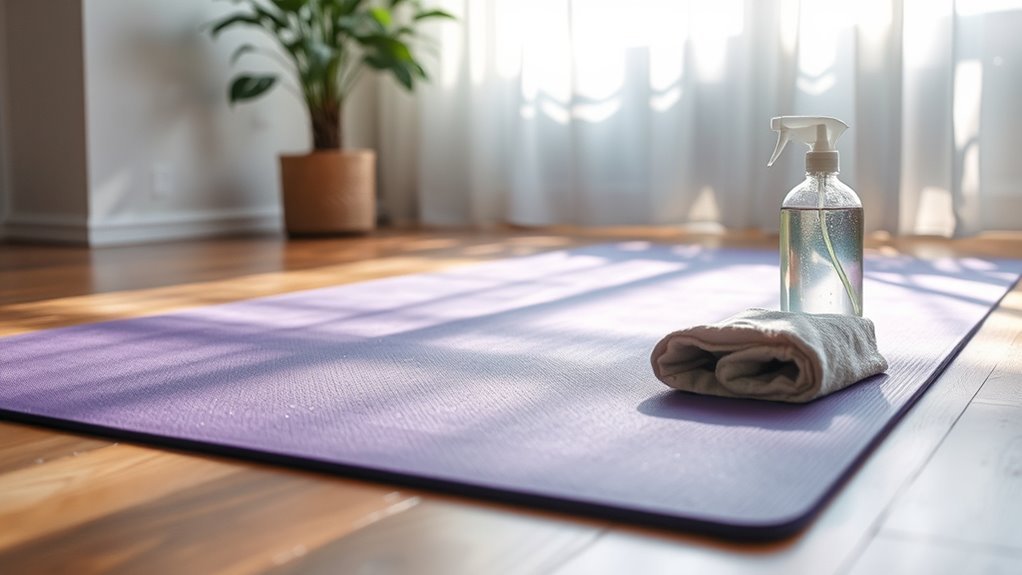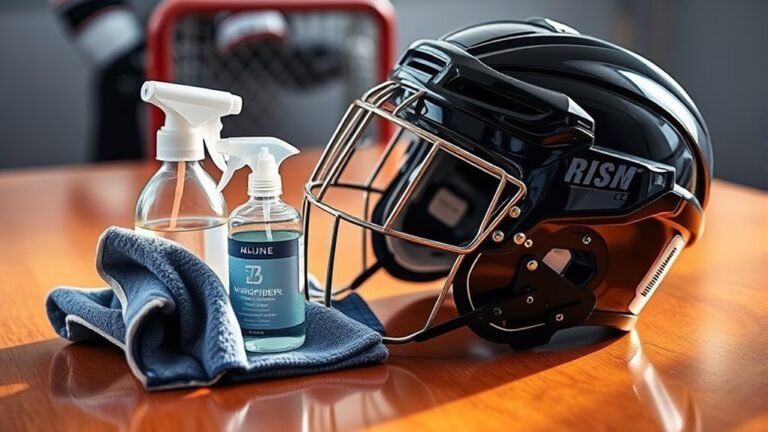The Right Way to Clean and Sanitize Your Yoga Mat
To clean and sanitize your yoga mat right, first know its material to avoid damage. After each use, wipe it with a damp cloth or a gentle natural spray, then let it air dry completely. For a deeper clean, use mild soap or vinegar once a month, scrubbing gently and rinsing well. Always dry and store your mat in a cool, ventilated spot away from sunlight. Following these steps keeps your mat fresh and ready—there’s plenty more to explore about proper care.
Understanding Your Yoga Mat Material
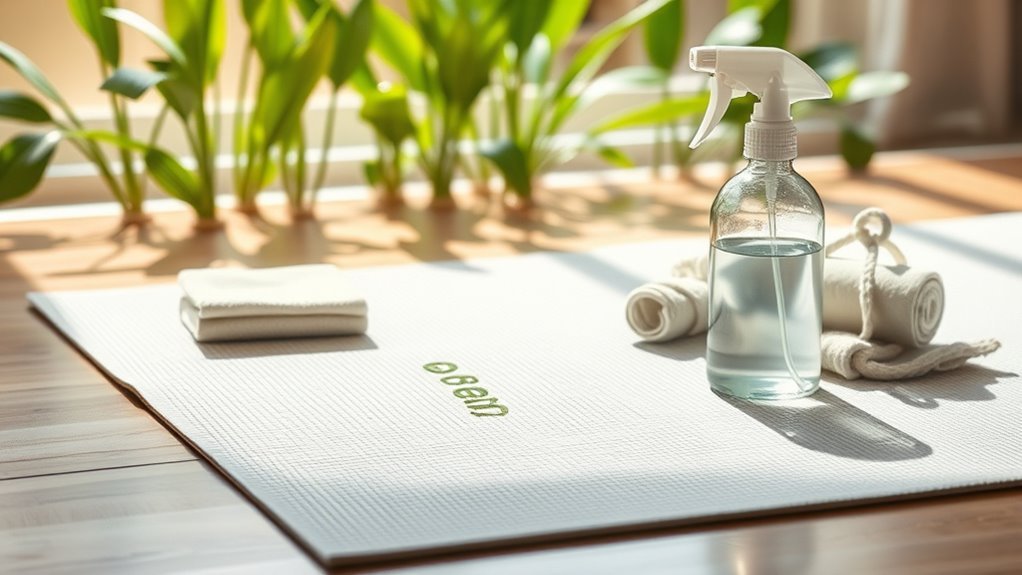
Knowing what your yoga mat is made of is key to cleaning it properly. Different material types—like PVC, natural rubber, or TPE—each have unique durability factors that affect how you should care for them. For example, PVC mats are durable but can degrade with harsh chemicals, while natural rubber mats need gentler cleaning to maintain their eco-friendly integrity. Understanding these materials lets you avoid damage and extend your mat’s life, so you stay free from unnecessary replacements. By recognizing your mat’s composition and its specific durability factors, you can tailor your cleaning routine to keep it fresh and functional without compromising its quality. This awareness empowers you to maintain your mat with confidence and freedom.
Daily Maintenance Tips for Your Yoga Mat
Once you understand your yoga mat’s material and how it responds to cleaning, keeping it in good shape becomes much easier. To maintain your mat’s freshness and longevity, make mat care part of your daily maintenance routine. After each session, quickly wipe down your mat with a damp cloth or a gentle, natural spray to remove sweat and dirt. Allow your mat to air dry completely before rolling it up to prevent mold and odors. Store it in a cool, dry place away from direct sunlight, which can degrade the material. This simple daily upkeep frees you from worrying about buildup and keeps your practice space clean and inviting, so you can fully enjoy your yoga flow without distractions.
How to Deep Clean Your Yoga Mat Safely
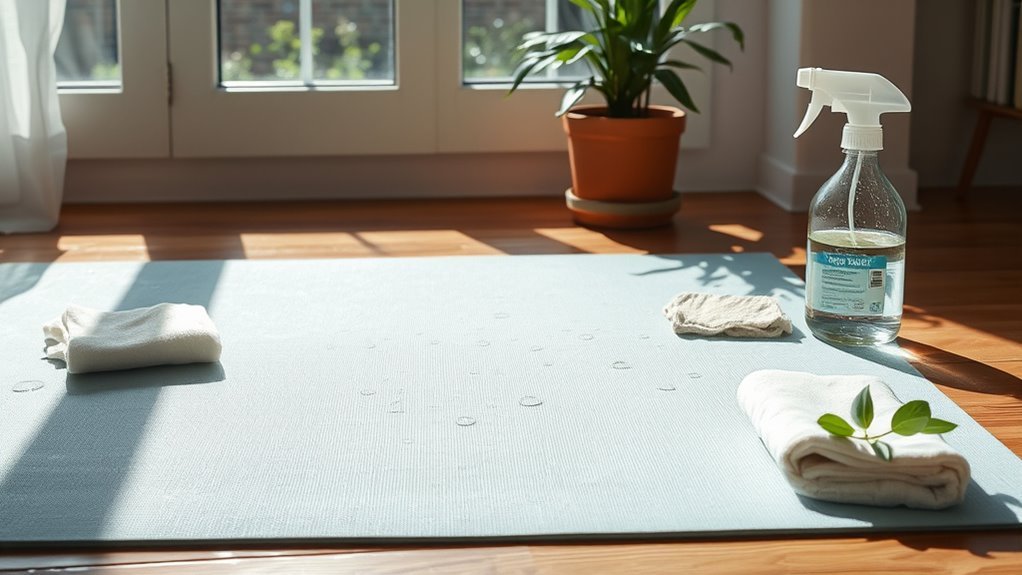
Deep cleaning your yoga mat is essential for removing stubborn dirt, sweat, and bacteria that daily wipes can’t handle. To keep your practice fresh and free, aim for deep cleaning once a month or more often if you sweat heavily. Choose eco friendly options like a gentle mix of water and mild soap or a vinegar solution to avoid harsh chemicals. Lay your mat flat or gently scrub with a soft cloth, ensuring you rinse thoroughly to remove any residue. Avoid soaking your mat to preserve its integrity. After cleaning, air dry it completely before rolling up. By sticking to a smart cleaning frequency and eco friendly methods, you’ll extend your mat’s life and maintain a clean space to move freely.
Best Natural and Commercial Cleaning Solutions
Although you can make your own cleaning solutions at home, there are also many commercial products designed specifically for yoga mats that offer convenience and effective sanitation. If you prefer natural alternatives, simple mixtures like diluted apple cider vinegar, tea tree oil, or gentle castile soap work wonders without harsh chemicals. These options let you stay true to a clean, eco-friendly lifestyle while keeping your mat fresh. On the other hand, commercial products often come with added ingredients to combat bacteria and odors more aggressively, saving you time and effort. Whichever route you choose, make sure the solution suits your mat’s material and your personal preferences. This way, you maintain freedom in your practice without compromising cleanliness or your values.
Proper Drying and Storage Practices
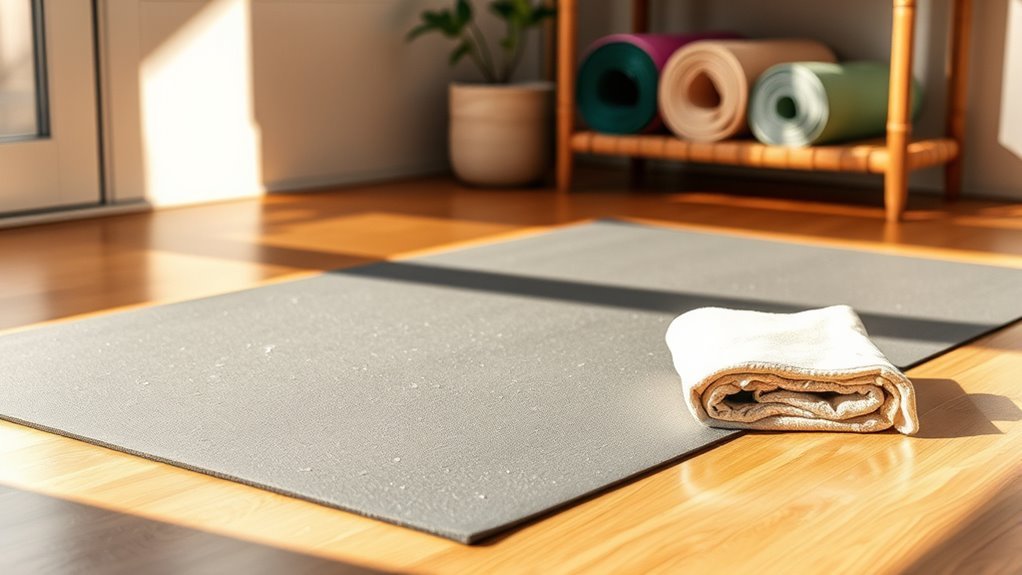
To keep your yoga mat in top condition, you’ll want to dry it thoroughly after cleaning to prevent mold and bacteria buildup. The best drying techniques involve air-drying your mat flat or hanging it in a well-ventilated space away from direct sunlight to avoid damage. Avoid rolling it up while damp—this traps moisture and invites mildew. Once dry, choose storage solutions that allow your mat to breathe. A mesh bag or an open shelf works well, giving your mat freedom to stay fresh and odor-free. Avoid cramped, dark spaces that can encourage bacteria growth. By mastering these drying and storage habits, you’ll extend your mat’s life and keep your practice feeling clean and liberating every time.
Frequently Asked Questions
Can Disinfectant Wipes Damage My Yoga Mat?
You might wonder if disinfectant wipes can damage your yoga mat. It really depends on the disinfectant ingredients and your mat material. Some wipes contain harsh chemicals like bleach or alcohol that can break down certain mat materials, causing cracks or stickiness. If you want to keep your mat feeling fresh without sacrificing freedom, choose gentle, natural wipes or those designed for your specific mat type, and always test a small area first.
How Often Should I Replace My Yoga Mat?
You should replace your yoga mat depending on its mat material and how often you use it. If you notice signs like cracks, peeling, or loss of grip, it’s time for a new one. Mats made from natural rubber or eco-friendly materials may wear differently than synthetic ones, so listen to your body and mat. Don’t let a worn-out mat limit your freedom—swap it out when replacement signs appear, and keep your practice fresh.
Is It Safe to Share My Yoga Mat With Others?
Sharing your yoga mat can be tempting, but it’s important to contemplate hygiene practices. Sweat, dirt, and bacteria build up during practice, so mat sharing might spread germs. If you want to share, make sure both of you clean and sanitize the mat thoroughly before and after use. This way, you maintain your freedom to connect while keeping your practice safe and healthy. Prioritize cleanliness to enjoy your yoga journey fully.
Can UV Light Sanitize My Yoga Mat Effectively?
Imagine your yoga mat as a garden basking in sunlight, where UV light acts like a vigilant gardener. Its UV light efficacy depends on the mat’s material—some absorb the rays better, while others shield hidden germs. If your mat’s made from dense or textured materials, UV rays might struggle to reach every corner. So, while UV can help sanitize, you’ll want to combine it with good old cleaning to truly free your practice from dirt and bacteria.
Do Antibacterial Sprays Affect Yoga Mat Grip?
You might find that antibacterial sprays can affect your yoga mat’s grip, depending on the antibacterial ingredients and your mat material. Some sprays contain chemicals that leave a residue, making the surface slick or less tacky. If you want to maintain freedom of movement and grip, it’s smart to test a small area first or choose sprays with natural antibacterial ingredients that won’t compromise your mat’s texture.
